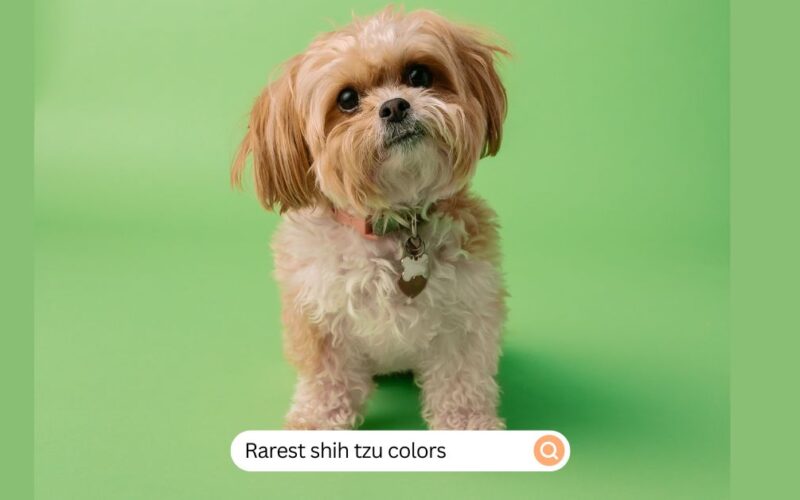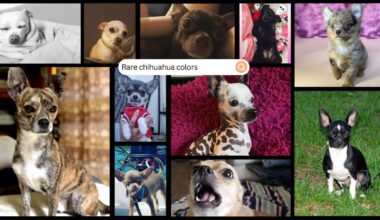About the Author: Jean Colt, a valued writer at MyPetDoggie and a dedicated student of English Literature at Yale University. Jean’s love for dogs, coupled with her literary skills, allows her to create engaging content that resonates with our pet-loving community. Her work reflects her passion for dogs and commitment to enhancing pet care knowledge.
Shih Tzu is a small dog breed especially known for children’s pets. Standing between 8 and 11 inches and weighing between 9 to 16 pounds, this cute little dog is a real charmer.
They have a thick, flowing double coat that comes in various colors to add more versatility to this cute breed.
It is important to understand the colors within this breed to identify the breed accurately. Some colors are common, some are rare and some are the rarest colors to find.
Scroll down to have thorough information regarding the rarest Shih Tzu colors.
20 Rarest Shih Tzu Colors
- Single (Solid) Colored Shih Tzu
- Black
- White
- Blue
- Brindle
- Parti-color
- Gold
- Red
- Liver
- Silver
- Lavender or Isabella
- Albino
- Rarest Bi Colored Shih Tzu
- Black and white
- Red and white
- Blue and White
- Liver and white
- Blue and Tan
- Rarest tri-colored shih tzu
- Black + White + Tan
- Liver + White + Tan
- Blue + White + Tan
- Red + White + Black
Single (Solid) Colored Shih Tzu
There are single (solid) colors in Shih Tzu that are known are rarest, some of them are:
Black
Solid colored shih tzus are rare and black is the rarest of all colors among this breed. If you find a single splotch of another color, be sure not to pay the price of a black shih tzu.
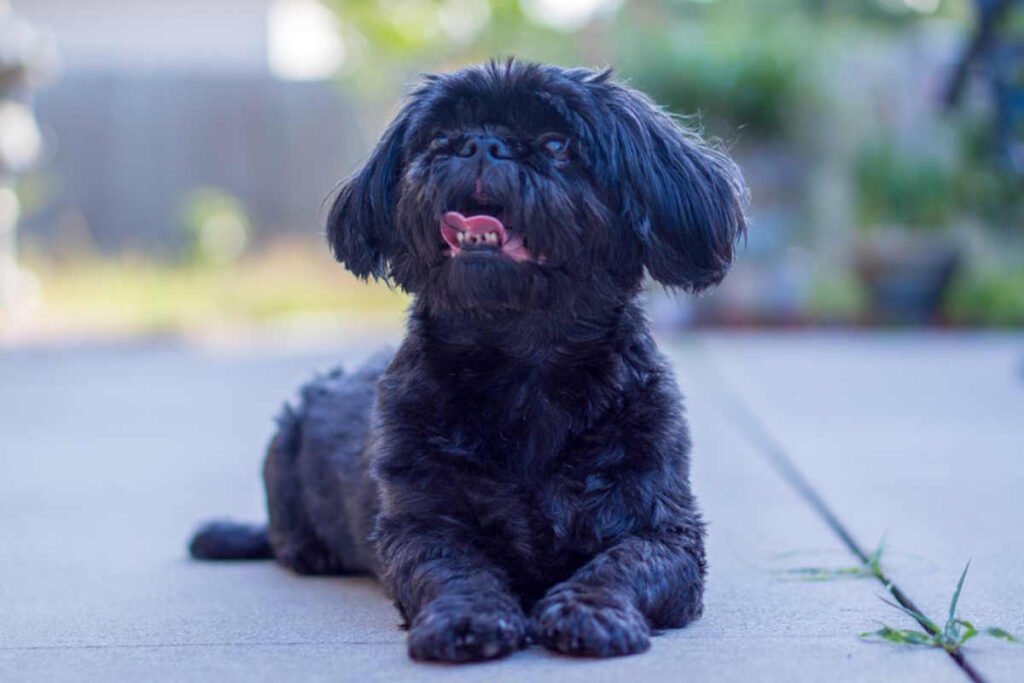
Black Shih Tzu is black overall, the eyes, paws, chest, coat, and even the eye rims are also black. So much so that you will not be able to see your black pet in the dark.
Most black shih tzus are comfortable in a warm environment. They also need proper brushing and cleaning of their coat as the black color hides the actual dust in the coat.
It is also worth mentioning that these types are an easy target for certain skin problems like allergies or hot spots.
White
Since white is recessive to other colors, this is considered one of the rarest shih tzu colors among shih tzu breeds. They have a slightly round face with large expressive eyes. The nose is black on a white Shih Tzu.

Any dirt or mud is easily visible on a white coat, making it easy to maintain with proper cleaning and frequent bathing. This color source is mainly due to the dilution of the genes or lack of pigmentation.
Some researchers do not consider pure white shih tzu as a rare color among shih tzus probably because AKC does not identify white as a standard color. It is still my recommendation to examine the pup thoroughly if you want to buy a white Shih Tzu.
Blue
The blue color is one of the rarest shih tzu colors, as it is caused by a dilution gene that affects the expression of black color in the coat. They mostly look silver-gray or charcoal but when you see them in proper light, you can visibly see the noticeable blue shimmering.
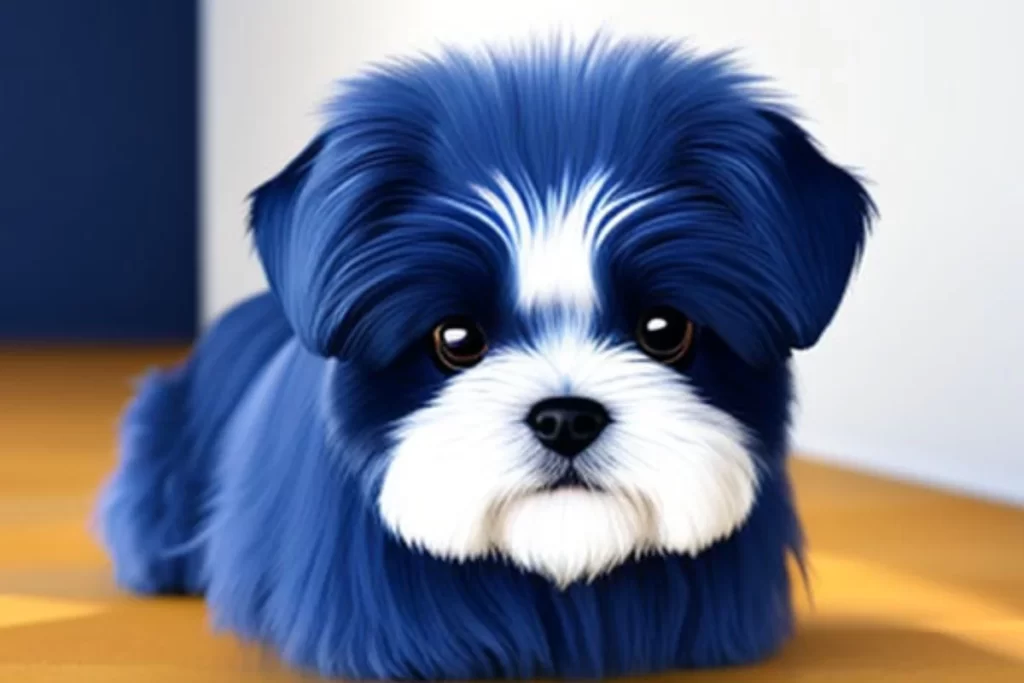
They tend to have pale-colored or blue eyes and a black nose that give them a distinctive look.
You might confuse a blue Shih Tzu with a black one if you are choosing from the photographs. So I recommend personally visiting the breeder when you intend to buy a blue Shih Tzu.
There are some rumors regarding the health risks of this type of shih tzu but there is no scientific evidence so far.
Brindle
It is a tiger-stripe-like coat color. It is a pattern of a mixture of brown, black, and sometimes white. It is noticeable that the color may change as the dog ages. It can fade or alter completely. This breed showcases a unique appearance with streaks or stripes of darker color interwoven into a lighter base color.

The brindle coat pattern is influenced by genetic factors involving the E and K locus genes, resulting in this visually intriguing look. Each Brindle Shih Tzu displays a one-of-a-kind pattern due to genetic complexities.
Regular grooming is essential to maintain their striking appearance. With a rich history as royal companions and a blend of genetic factors creating their distinct coats, Brindle Shih Tzus is cherished for its unique and captivating presence.
Parti-color
A parti dog is one with a white base coat of about 50% and another color. It is a combination of white and any other color with large patches.

This variation features patches of white mixed with other colors like black, brown, or gray, resulting in a distinctive appearance.
Genetics play a key role in the development of these coats, creating individualistic patterns. Proper grooming, including regular brushing, bathing, and trimming, ensures their coat’s health.
Gold
Golden Shih Tzus exhibit an intriguing color transformation, often fading from gold to pale yellow as they age. This change occurs unpredictably, either during puppyhood or young adulthood

The enduring gold color is considered one of the most appealing shades for Shih Tzus, though less common than other varieties. While some gold Shih Tzus display mixed markings, these aren’t classified under the 091 registration code.
Newborn pups boast glamorous gold coast that can evolve to a subtler shade if the gold persists. The range of gold hues spans light tan to deep gold due to complex genetic interactions.
Red
Distinguishing a red Shih Tzu from a golden one with an orange tinge can be confusing, especially in adulthood. However, red Shih Tzu puppies appear notably redder than their golden counterparts.

The color transformation occurs after puppyhood, and occasional instances involve red Shih Tzus born almost entirely black. Adults might be mistaken for liver Shih Tzus, but reds have black points while livers possess brown attributes, mainly in paws and nose.
The red pigment is dominant, creating variations from gold to tan based on genetic interactions.
Bi-colored/tri-colored Shih Tzus with red aren’t under standard red codes, except for mild black markings. Red Shih Tzus stand out and are comparatively affordable.
Liver
The liver coat color, a rare yet sought-after shade in Shih Tzus, varies from light to deep brown. This recessive gene-induced hue requires both parents to carry the gene, and regular grooming is vital for maintenance.

Sun protection guards against fading, as liver color is prone to it. This stunning color, among the rarest shih tzu colors, arises from diluted black pigment due to the B locus gene. While the term “liver” refers to skin color, coat shades can differ from dark chocolate to lighter tones.
Breeding liver Shih Tzus demands both parents carrying the gene, or black Shih Tzus with dilution genes can yield liver-colored pups. Despite challenges, liver Shih Tzus remains coveted, emphasizing reputable breeders for accuracy.
Silver
When it comes to Shih Tzu colors, white isn’t officially accepted by the AKC, but silver is. Sounds a bit confusing, right? I know that white is common in many breeds.

The thing is, white Shih Tzus can be mistaken for albinos due to the lack of pigmentation. Although silver has a genetic link to Weimaraners, it’s recognized as a Shih Tzu color.
You’ll spot a silvery sheen on silver Shih Tzus’ coats, setting them apart from white ones. Just remember, silver pups might look similar, but they’re pricier. They need more grooming too, so be ready for that shiny coat upkeep!
Lavender or Isabella
Lavender coats are real showstoppers in the dog world, not just for Shih Tzus. They’ve got this unique purple/gray vibe thanks to the MLPG gene.

Yes, the same gene behind blue coats, but here it dilutes brown instead of black. They’re kind of rare among the rarest Shih Tzu colors, so they’re pricier, but worth the attention.
Lavender, Isabella, and lilac Shih Tzus? All the same gorgeous color! AKC might not list it, but these cool coats with hazel eyes are a real treasure, bred by trusted folks.
Albino
Albino Shih Tzus might not be recognized as an official color, but they’ve got their spotlight. It’s not the same as white – there are key differences

Firstly, their bluish eyes set them apart, making them sensitive to light. Secondly, the dilution gene takes them to an extreme level of paleness, affecting their skin too. Pink noses and paws are their thing due to lack of pigmentation.
Targeting indoor dog lovers, albino Shih Tzus are low-maintenance but health needs attention. They’re unique, attractive, and perfect for the right dog parent.
You might be interested in: Explore the different types of dog fences and their suitability for your pet.
Rarest Bi Colored Shih Tzu
The bi-colored shih tzu is even more adorable in looks and gentle in behavior. I like bi-colored breeds among all the rarest Shih Tzu colors. These are some of the color combos that are recognized and registered in AKC.
Black and white
Black and white Shih Tzus are such a popular pick, and you can easily find them.

These cuties usually rock a white spot on their head, with the rest being black, while the body is mostly white. Their unique patterns make them stand out.
I adore them, especially in their puppy trim! Just remember, those patterns might evolve, like turning gray or silver as they grow older.
Red and white
You know what’s cool? The red and white Shih Tzu.

It’s like a more vibrant version of the liver Shih Tzu with an extra dash of red. While you won’t find blood-red ones, AKC named them red and white, even though there are solid reds. They usually rock white legs, sometimes due to genetics.
I find them beautiful, whether it’s deep mahogany or lighter ginger. The white patches add a neat contrast, just like other Shih Tzu colors.
Blue and White
Alright, let’s talk about blue and white Shih Tzus! They’ve got this cool mixed coat thing going on—white and blue all over or intermixed.
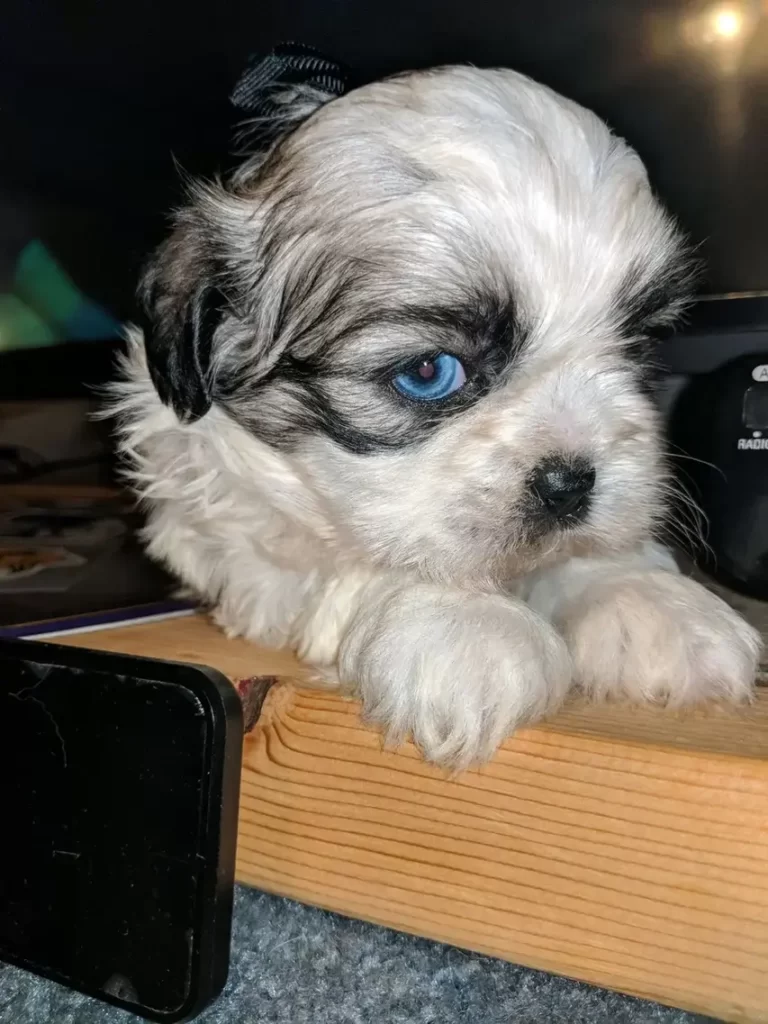
Not as rare as solid colors, you’ll spot them often. Now, here’s the twist: blue Shih Tzus are kind of a paler black, with diluted skin.
But the kicker? Black Shih Tzus are about their coat, not skin. A bit tricky, but that’s the charm. Blues are like a silvery grayish tone, born unique with their noses and all.
Liver and white
Liver and white Shih Tzus are like elegant brown and white pups. Their hue sits between gold and Brindle. And guess what? The long-haired ones?

Super majestic, thanks to that killer color blend. It’s all about that aesthetic mixing. So, if you’re into classy colors, these Shih Tzus might just steal your heart.
Blue and Tan
Now let’s talk about Shih Tzu colors! Black and tan, is pretty common, right?
Those tan marks are regular on black dogs, but here’s the twist: the dilution gene turns the black into cool blue.

These marks show up all over—parti, tuxedo, and spotted styles. So, if you’re eyeing a blue Shih Tzu pup, these markings are usually there. Super common, you’ll spot them around quite often.
Rarest tri-colored shih tzu
Tri-colored Shih Tzus are uncommon; their coats blend black, white, and brown. Black base, white chest/face/feet marks, and brown eyebrows/eye area define their unique look.
Alright, let’s dive into some awesome Shih Tzu coat color combos!
Black + White + Tan
- Picture a pup with a trio of colors. Black’s the base, while white and tan create accents. You might spot white on the chest, paws, and maybe a stripe on the face. Tan adds a warm touch, often highlighting eyebrows and cheeks.

Liver + White + Tan
- Imagine the same trio, but now with a liver (rich brown) base. White and tan blend in, giving a cool contrast. You’ll likely see white on the chest and paws, while tan adds flair around the eyes and eyebrows.
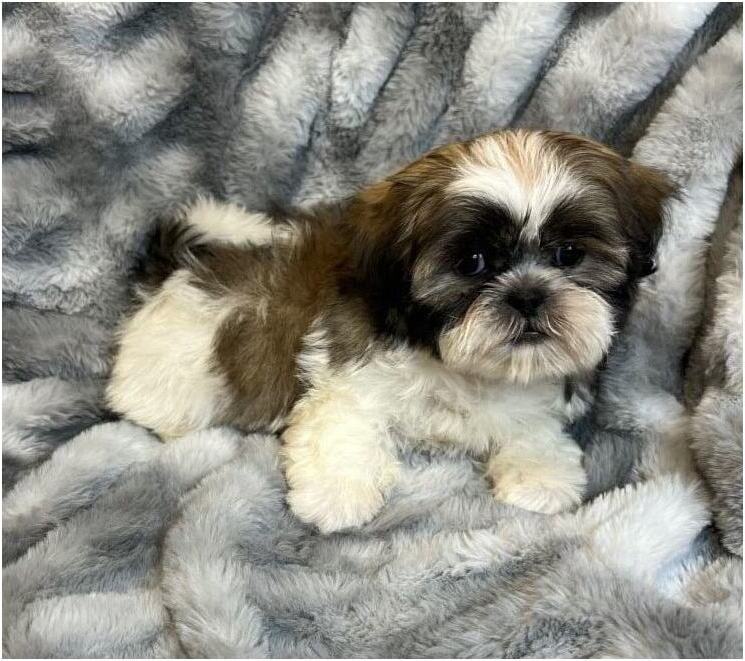
Blue + White + Tan
- Think of blue—like a soft grayish-blue—mixing it up with white and tan. The coat’s main color is this soft blue, while white and tan marks add character. White’s on the chest and paws, and tan brings warmth to the eyebrows and cheeks.

Red + White + Black
- Now we’re talking about drama! Red’s the star here, with black and white as supporting actors. Red dominates, and white might be on the chest and paws. Black details can show up, too. It’s like a stylish ensemble.

Each combo gives these adorable pups a unique look, showcasing their colors in a way that’s both eye-catching and charming. And that’s what makes Shih Tzus so paw-sitively wonderful!
You might be interested in: Learn about the rare colors of Chihuahuas and their characteristics.
Caring for Rare Colored Shih Tzu
It must be widely understood how to take proper care of your rare colored shih tzu. I have researched and jotted down some points for a quick overview.
Regular Grooming:
- Brush several times a week to prevent matting and remove loose hair.
- Use a suitable brush or comb for your dog’s coat type.
Bathing:
- Bathe regularly with gentle dog shampoo to keep the fur clean.
- Rinse thoroughly to avoid residue, and dry gently.
Overall Health:
- A balanced diet supports a shiny coat.
- Consult a vet for proper nutrition and food choices.
- Exercise and mental stimulation contribute to coat health.
Skin Concerns:
- Watch for signs of skin issues or allergies.
- Consult a vet for timely treatment.
Maintaining Coat Color:
- A balanced diet with nutrients for healthy skin.
- Regular grooming removes debris and dead hair.
- Protect from sun exposure to avoid fading.
- Monitor health conditions affecting coats.
- Avoid chemical exposure to maintain color.
Vibrant Coat:
- Follow these tips for a healthy, colorful Shih Tzu coat.
How White Shih Tzu Develop Colored Markings
White Shih Tzus can develop colored markings due to various factors.
The presence of specific genes and genetic combinations can lead to these markings, even in predominantly white-coated dogs. This phenomenon occurs because the same genes that determine coat color can also influence the distribution of pigments on the coat.
As a result, patches, spots, or markings of different colors may appear on a White Shih Tzu’s coat. This adds a unique and charming aspect to their appearance, making each dog truly one-of-a-kind.
Best Markings for a Shih Tzu Coat
The “best” markings for a Shih Tzu coat are subjective and depend on personal preferences. However, many people find symmetrical and well-defined markings appealing. Some popular markings include the following.
Full Mask:
- This refers to a darker color covering the entire face of the Shih Tzu, often giving the appearance of a “mask.” The mask color can vary, but it’s distinct from the rest of the coat.
Black Nose:
- Simply put, the Shih Tzu has a completely black nose. This is a common and classic trait in many dogs, including the Shih Tzu.
Blaze or White Stripe:
- A “blaze” or “white stripe” is a narrow, vertical line or streak of white running down the center of the dog’s face, often between the eyes. It contrasts with the surrounding coat color.
White Chest and Paws:
- This refers to areas of the Shih Tzu’s chest and paws that are white. The chest area is the front portion of the dog’s body, and the paws are the feet. These white areas can create a striking contrast with the rest of the coat.
Saddle or Sable:
- “Saddle” or “sable” markings involve a darker color, often extending over the back of the Shih Tzu’s body, similar to a saddle placed on its back. The color can be richer and deeper in this area.
These markings contribute to the Shih Tzu’s unique appearance and are part of what makes each dog special and charming in their way.
Which Shih Tzu Color is Right for You?
Choosing the ideal Shih Tzu color hinges on personal taste, lifestyle, and grooming willingness. Factors like aesthetics, living environment, and pattern preferences play a role. Remember, each color boasts its charm and uniqueness.

Let your heart guide you toward the Shih Tzu color that resonates with you and suits your life best.
- For Pet Parents Looking for Relatively Cheaper Shih Tzus
The price ranges from $500 to $1800. It depends on your budget and which option and color you choose for your pet.
- For Pet Parents Looking for Expensive and Rare Shih Tzus
If you are looking to have an extraordinary pet and budget is not your problem then you should opt for white, blue, brindle, gold, red, and the rarest shih tzu color; the black one.
- For Pet Parents Looking for Indoor Pets
If you’re seeking the perfect indoor companion, consider the Shih Tzu breed with bi-colored markings. With their small size, gentle nature, and adaptable temperament, Shih Tzus make wonderful indoor pets.
Common Question Regarding Shih Tzu:
What type of Shih Tzu is expensive?
Shih Tzus with rare coat colors or unique markings tend to be more expensive.
Are chocolate Shih Tzus rare?
Yes, chocolate Shih Tzus is considered rare.
Is Shih Tzus special?
Absolutely, Shih Tzus are special! Their charming personality, affectionate nature, and unique coat colors make them stand out.
What does a pure Shih Tzu look like?
A pure Shih Tzu typically has a distinctive appearance characterized by a long, flowing coat, a pushed-in face with a short muzzle, and a luxurious mane of hair around the head. Their eyes are large and expressive, and their ears are floppy. They have compact and sturdy body with a curled tail resting over their back.
Does Shih Tzu bark a lot?
Shih Tzus are known for their tendency to bark, though the level of barking can vary from one individual to another.
What are Shih Tzus best at?
They’re exceptional as companions, offering unwavering loyalty and affection. Their compact size makes them great for apartment living, and they’re wonderful indoor pets,
How do I know my Shih Tzu is original?
To confirm the authenticity of your Shih Tzu, choose a reputable breeder, obtain valid pedigree papers, compare physical traits, seek professional opinions, and verify health records.
Final words
In conclusion, exploring the world of Shih Tzu colors unveils a spectrum of beauty. From the sought-after rarest Shih Tzu colors to the more common varieties, each hue adds a unique charm to these beloved companions.
